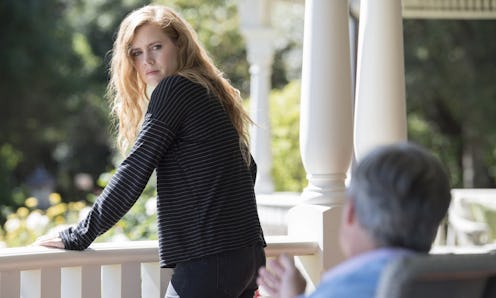Books
If You Love 'Sharp Objects,' Read These 9 Books With Equally Unreliable Narrators

I can still remember opening to the first page of Gillian Flynn's Sharp Objects nearly three years ago. Within a handful of hours, I'd burned through most of the book, pulled in deep by the voice of Camille Preaker, the protagonist and narrator of Flynn's 2006 literary debut. After Sharp Objects, I began to seek out books with unreliable narrators. Because it wasn't just the terrifying plot points or Flynn's electrifying neo-noir aesthetic — it was the spell Camille's voice cast over my brain, lulling me into complacency until pinpricks of doubt began to set in. Could Camille be trusted as the narrative voice? And if not, then could anyone be trusted?
The term "unreliable narrator" was coined in the 1960s by literary critic Wayne Booth, though the technique — establishing a first-person narration and then chipping away at their reliability as unbiased truth-tellers — has been a storytelling technique since, well, people first began telling stories. Booth saw literature as a "compact" between the author and the reader, and at the heart of this complicated relationship was rhetoric, persuasive, narrative writing. And it brought into focus an uneasy, nebulous question: how often do we convince ourselves of something other than the truth? And when we engage in that act, are we conscious of it?
Within the world of fiction, the use of an unreliable narrator preys upon our inherent trust in the voice guiding us through a story. There's a reason so many of these books are classified as "horror" — self-doubt in our ability to see the world as it really is, a shaken trust in our concepts of reality, are bone-chillingly, goosebump-y, brain-in-a-tornado creepy.
'The Girl On The Train' by Paula Hawkins
The 2015 smash hit The Girl on the Train (adapted into a 2016 movie starring Emily Blunt) is arguably the most widely-read example of an unreliable narrator in recent years. Told at an increasingly frenetic pace, the book follows Rachel on her daily ride on a commuter train - and the horror she uncovers while looking out the window.
'What Was She Thinking? [Notes On A Scandal]' by Zoe Heller
Barbara Covett is lonely. A single schoolteacher, well into middle age, Barbara keeps a detailed, often sardonic journal documenting her mundane existence - that is, until the arrival of art teacher Sheba Hart. Beautiful and free-spirited, Sheba captures the attention of the school, including Barbara and including... well, others. And as Sheba's lacquered life begins to crumble, Barbara is there — watching and waiting.
'We Have Always Lived in The Castle' by Shirley Jackson
Shirley Jackson's reign as Queen of Gothic Horror is solidified in this unsettlingly 1962 novel about the three surviving members of a small town's formerly prominent clan.
At 18, "Merricat" Blackwood lives with her agoraphobic older sister Constance and their wheelchair-bound uncle, Julian, locked away on the family estate after a spate of poisoning killed the rest of the family. Merricat is now their protector, living a life dictated by omens and self-imposed rules. When cousin Charles appears, Merricat must decide whether to allow this outsider into their home — or act swiftly to keep him out.
'Alias Grace' by Margaret Atwood
Inspired by the real-life trial and imprisonment of 16-year-old servant Grace Marks, convicted of murdering her employer and his mistress, Atwood weaves an exceptionally chilling portrait of deception, manipulation and perception, as Grace is repeatedly interviewed by a fledgling mental health expert attempting to win her a pardon.
'Room' by Emma Donoghue
Five-year-old Jack's whole world is a room — a room in a shed where his mother, kidnapped as a teenager, has been kept for years. But one day, Jack gets out, and we, along with Jack, get to experience the world, again, from the beginning, with all its colors and sounds and lingering, festering pain.
'The Walls Around Us' by Nova Ren Suma
This surreal ghost story intertwines the voices of two girls, one "outside" — Violet, a teenaged dancer days away from her big break and teetering on the edge of a sinister truth - and "inside" — Aurora, locked away in a juvenile center for so long she's nearly forgotten a life before. And before you make it to the end of this haunting urban legend, you may begin to wonder: can we be trusted in the stories we tell ourselves?
'The People In the Trees' by Hanya Yanagihara
Like so many books on this list, The People in the Trees plays, chillingly so, with moral relativism. When a young doctor, Norton Perina, embarks on a tropical expedition with a renowned anthropologist, he hardly expects to stumble upon "The Dreamers," a long-living but increasingly senile group of forest dwellers. When Norton smuggles their secret to longevity across the ocean, he receives a global amount of acclaim, while her personal demons close in.
'The Remains of the Day' by Kazuo Ishiguro
As Stevens, the epitome of a loyal butler, reflects on three decades of service to Lord Darlington during a countryside drive and a deep dive into the past. Stevens reassures himself, increasingly desperate, that he has served humanity well by serving "a great gentleman" well - but that all balances, of course, on the moral purity (or lack thereof) of Lord Darlington.
'We Were Liars' by E. Lockhart
An engrossing YA novel of deception, murder and childhood friendships tip-toeing their way into adulthood — if that's not the definition of "creepy beach read," then... we have different definitions of, uh, that. Set on a private island, within a prominent family for whom appearance means everything, this story of love and loss and lies will grab hold and pull you under.